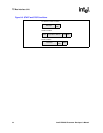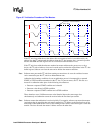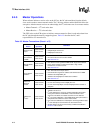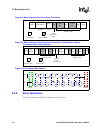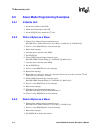
9-12 Intel® PXA255 Processor Developer’s Manual
I
2
C Bus Interface Unit
9.4.5 Master Operations
When software initiates a read or write on the I
2
C bus, the I
2
C unit transitions from the default
slave-receive mode to master-transmit mode. The 7-bit slave address and the R/nW bit follow the
start pulse. After the master receives an acknowledge, the I
2
C unit enters one of two master modes:
• Master-Transmit — I
2
C unit writes data
• Master-Receive — I
2
C unit reads data
The CPU writes to the ICR register to initiate a master transaction. Data is read and written from
the I
2
C unit through the memory-mapped registers. Table 9-5 describes the I
2
C unit’s
responsibilities as a master device.
Table 9-5. Master Transactions (Sheet 1 of 2)
I
2
C Master
Action
Mode of
Operation
Definition
Generate clock
output
Master-transmit
Master-receive
• Master drives the SCL line.
• ICR[SCLE] bit must be set.
• ICR[IUE] bit must be set.
Write target
slave address
to IDBR
Master-transmit
Master-receive
•CPU
writes to IDBR bits 7-1 before a START condition enabled.
• First seven bits sent on bus after START.
• See Section 9.3.3.
Write R/nW Bit
to IDBR
Master-transmit
Master-receive
• CPU writes to least significant IDBR bit with target slave address.
• If low, master remains a master-transmitter. If high, master
transitions to a master-receiver.
• See Section 9.4.2.
Signal START
Condition
Master-transmit
Master-receive
• See “Generate clock output” above.
• Performed after target slave address and R/nW bit are in IDBR.
• Software sets ICR[START] bit.
• Software sets ICR[TB] bit to initiate start condition.
• See Section 9.3.3.
Initiate first
data byte
transfer
Master-transmit
Master-receive
• CPU writes byte to IDBR
•I
2
C unit transmits byte when ICR[TB] bit is set.
•I
2
C unit clears ICR[TB] bit and sets ISR[ITE] bit when transfer is
complete.
Arbitrate for
I
2
C Bus
Master-transmit
Master-receive
• If two or more masters signal a start within the same clock period,
arbitration must occur.
•I
2
C unit arbitrates for as long as needed. Arbitration takes place
during slave address and R/nW bit or data transmission and
continues until all but one master loses the bus. No data lost.
• If I
2
C unit loses arbitration, it sets ISR[ALD] bit after byte transfer is
completed and transitions to slave-receive mode.
• If I
2
C unit loses arbitration as it attempts to send target address byte,
I
2
C unit attempts to resend it when the bus becomes free.
• System designer must ensure boundary conditions described in
Section 9.4 do not occur.





